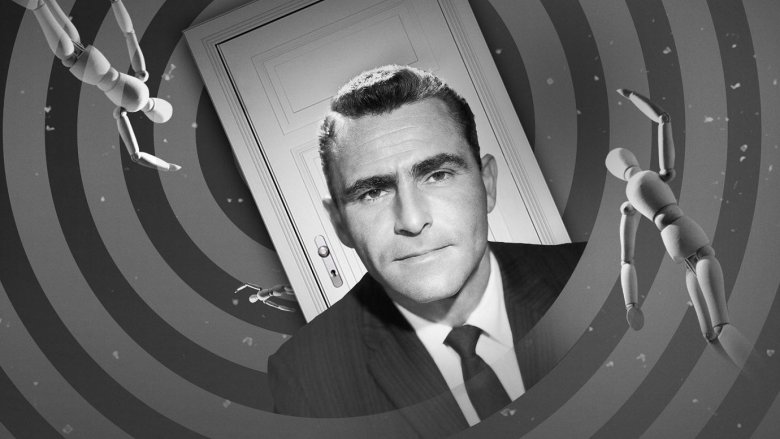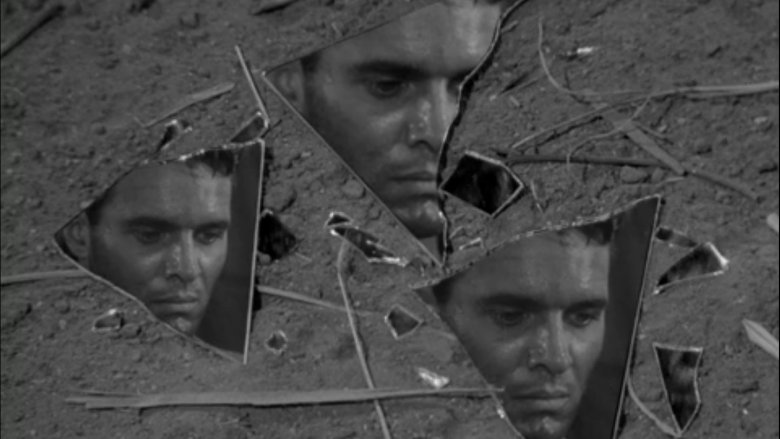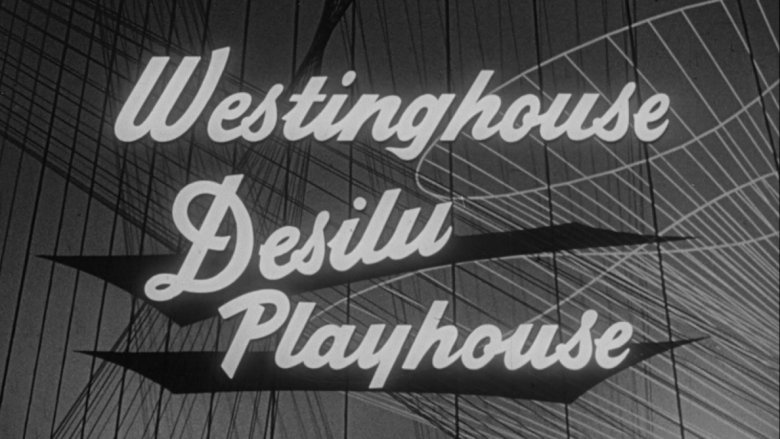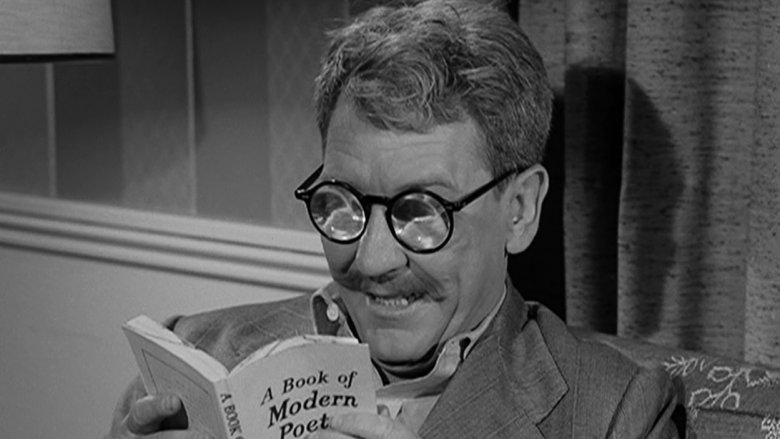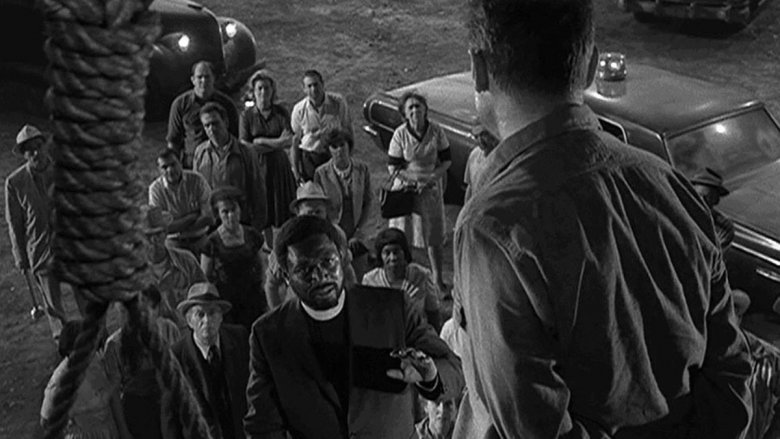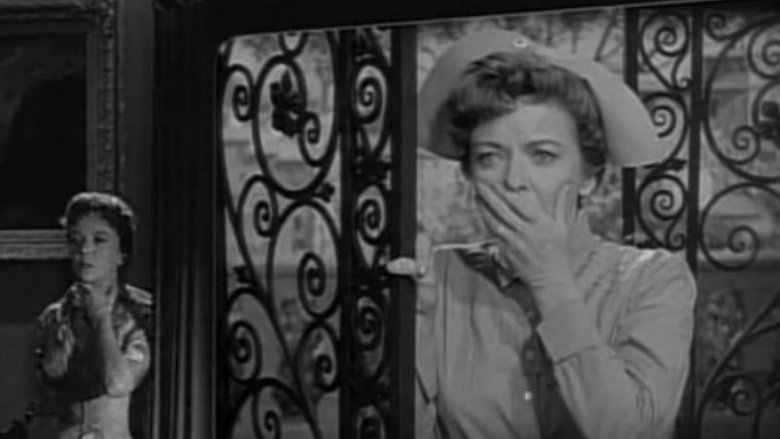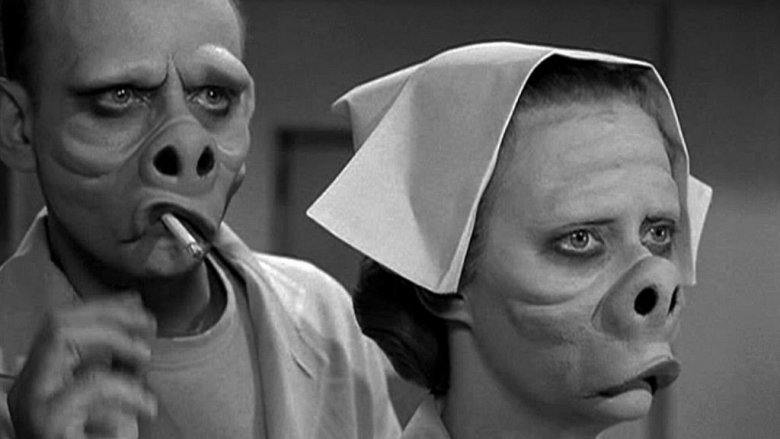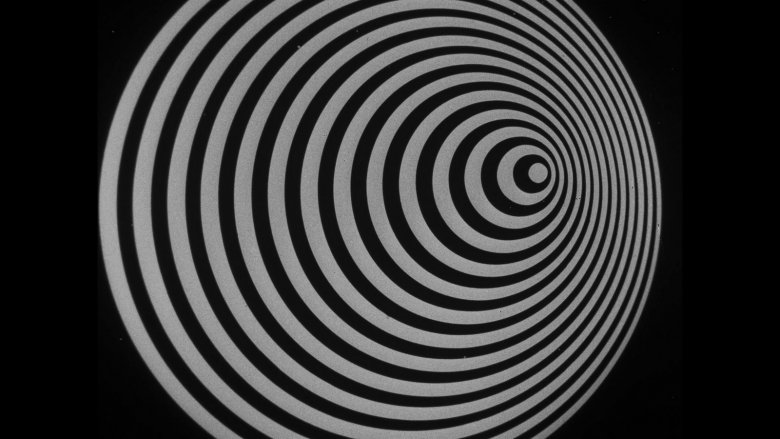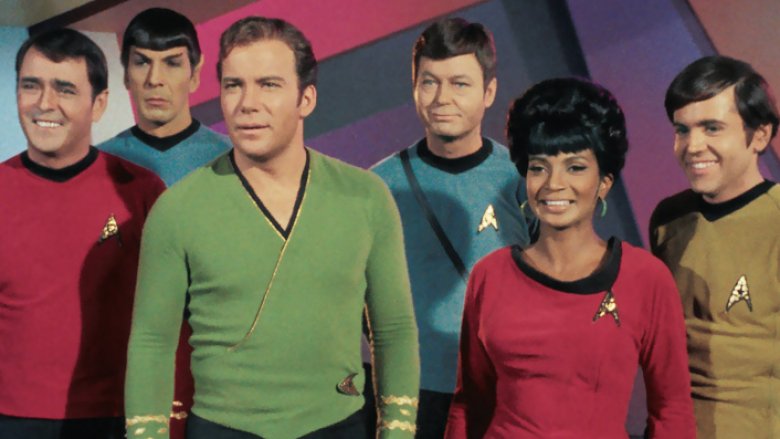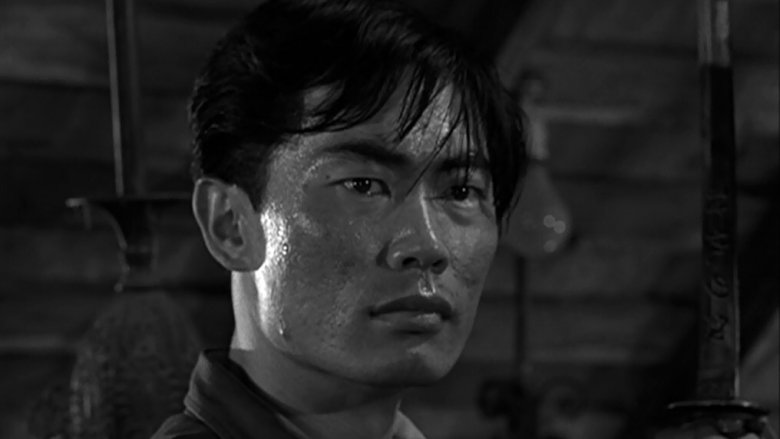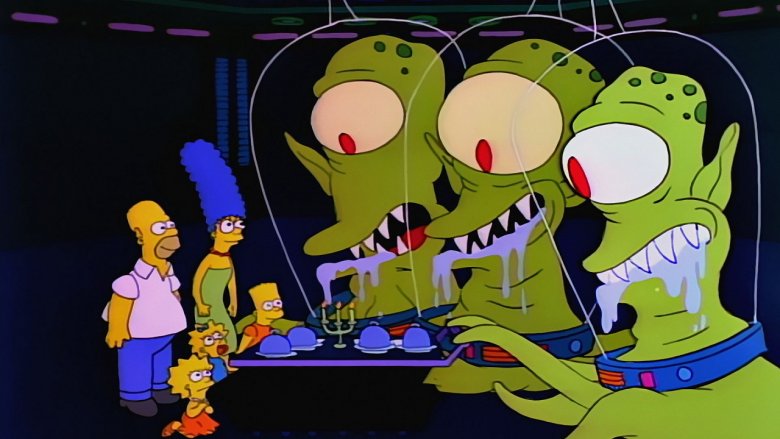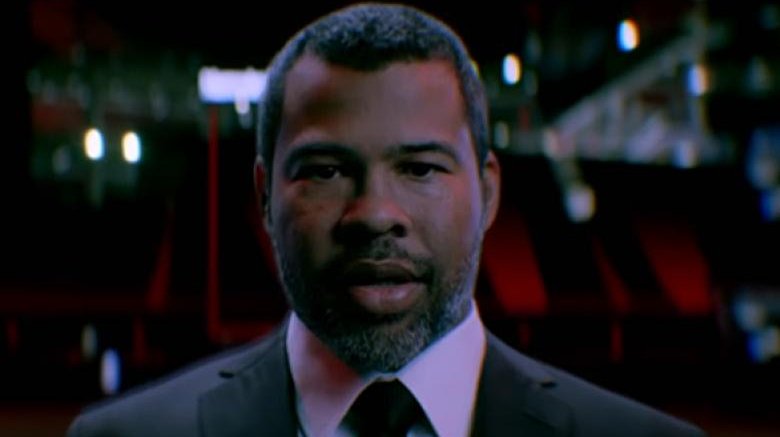The Untold Truth Of The Twilight Zone
You are entering a dimension without color but rich in texture, a dimension where asking "what if?" could prove dangerous. You are at the crossroads of time, where the lessons of yesteryear continue to speak truths about the human condition in your modern life. Everywhere, there are faces and names that you recognize but cannot place, people you're sure you heard your parents and grandparents talking about in the past. Your mobile device will not work here, and you'll have to turn in your vape pen for an old-fashioned cancer-causing cigarette, because this... is The Twilight Zone.
CBS recently released the first real trailer for Jordan Peele's upcoming adaptation of Rod Serling's classic speculative fiction television series, which began its original run in October of 1959. The trailer shows that Peele will be eschewing the black and white film, but he has also chosen to include many little tidbits and references that fans of the original will instantly recognize. But even though pretty much everyone recognizes the "doo di doo doo, doo di doo doo" of the Twilight Zone theme song, not everyone is familiar with Serling and his mind-bending Cold War-era fiction. It is therefore worth taking a look at what made that unlikely series the cult hit that it remains to be to this very day.
Writing to cope
Before Rod Serling was a multi-award-winning television writer, he had chosen to enlist in the United States Army during the final years of World War II. He was stationed in the Philippines for much of his time there, where he was constantly exposed to the harsh realities of war. Though he had gone into the military through patriotic choice rather than being drafted, his experiences there certainly colored his worldview going forward.
In an interview after Serling's death, his wife, Carol, discussed his experiences in the Army. She believed that he used writing as a way to work through a lot of the trauma he experienced during his time overseas, though post-traumatic stress disorder was not a diagnosis for veterans until later wars. Wartime settings were prevalent in The Twilight Zone, whether they be about World War II (as in "The Purple Testament," which takes place in the Philippines), or the then-current Vietnam War (as in "In Praise of Pip"). Even though Serling was a decorated veteran, he was very adamantly anti-war after his military experience, and those sentiments come through loud and clear in his writing.
"The Time Element"
Though the first official episode of The Twilight Zone was "Where Is Everybody?," the show's unofficial pilot was a one-hour segment on Westinghouse Desilu Playhouse, an anthology series helmed by television sweethearts Lucille Ball and Desi Arnaz. This episode, titled "The Time Element," ran in 1958, and it chronicles the tale of a bartender named Peter Jenson (played by William Bendix), who is having disturbing nightmares. In them, he is transported back 17 years to Hawaii on the eve of the Japanese attack on Pearl Harbor. He tries to warn everyone that an attack is imminent, but no one wants to listen.
In the present, he is describing the events to a psychiatrist, who assures him that time travel is not real and he is only dreaming, but every time the attack finally occurs in his dream, he is brought through the same loop all over again. Though this episode is rarely shown in syndication with the rest of the series, it introduced many of the elements that would define The Twilight Zone and served as a sounding-off point for Serling to convince CBS to approve the series the following year.
A focus on writing
Serling had already won three of his Emmy awards by the time The Twilight Zone was set to launch in 1959, and he wrote 92 of the show's 156 episodes. But he had a deep regard for his fellow writers, and he welcomed many of television and literature's great names to pen episodes of their own. Charles Beaumont, who wrote 22 episodes of the series, was also a prolific short story author who penned tales for Amazing Stories, Orbit, Playboy, and Esquire, among many other magazines and anthologies. Richard Matheson had already written the vampire classic I Am Legend in 1954 before taking on 16 episodes of The Twilight Zone. And even famed science-fiction writer Ray Bradbury got an episode in, "I Sing the Body Electric!," though he and Serling had a rather contentious relationship much of the time. Serling would also adapt short stories by many authors to fit the frame of an episode. Among these is "Time Enough at Last," a heart-wrenching tale for any bookworm, originally written by Lynn Venable.
Speculative fiction as social commentary
Despite Serling's assertions in a 1959 interview with Mike Wallace that he didn't want to deal with controversial topics any longer, The Twilight Zone was able to bring light to many social and political issues of the time through the use of allegory. Television in the '50s and '60s was deeply conscious of upsetting audiences, and sponsors wanted to make sure that those audiences would be inspired to buy their products. This meant many strict guidelines were placed on writers, and Serling was tired of having to play the back-and-forth game with studio executives.
He turned toward speculative fiction as sophisticated adult entertainment that he claimed wasn't "important," but it seems that it was impossible to take the activist out of the writer. Serling was writing during a time of great political turmoil; the Vietnam War had begun four years prior to the series' debut, there was the constant fear of a nuclear disaster, and racial tensions were gripping the nation. In the episode "I Am the Night — Color Me Black," a man is sentenced to be hanged after allegedly killing a bigot who was beating a black man. On the day of his execution, however, the sun refuses to rise. At the end of the episode, the audience learns that the sun hasn't risen over many other locations, including North Vietnam, a section of the Berlin Wall, and Birmingham, Alabama. The closing narration states: "A sickness known as hate. Not a virus, not a microbe, not a germ — but a sickness nonetheless, highly contagious, deadly in its effects. Don't look for it in the Twilight Zone — look for it in a mirror. Look for it before the light goes out altogether."
Underappreciated in its time
In a previously lost 1970 interview with writer and professor James Gunn, Serling talks a little bit about the television ratings system (the arithmetic of which he says is "very close to insanity") and where The Twilight Zone fell in the grand scheme of things. It was considered a moderate success, doing well enough to continue its run but not so integral to the network that it couldn't be replaced by a different, more promising show in its spot.
Moderate success, in this case, means that it was being watched by about 25 million people, or about 14% of the US population in 1960. It went through a few cancellations and resurrections until Serling finally decided to call it quits after CBS gave it the axe once more in 1964. Its late-night air time and mature drama, as well as its increasingly-outdated anthology format, may have all been factors in its not being a runaway success, but it is still lauded today as a classic of television while its late-night competitors like The Detectives and Dr. Kildare are all but forgotten.
High tension on a low budget
Though the series often went over-budget and wasn't raking in the views that the network desired, Serling and his team often had to make do with the best they could afford. This was a time before computerized special effects, obviously, so much of the drama and tension had to be created through camera and make-up know-how, or in the case of "The Invaders," using small-scale puppets to convey a size difference between actress Agnes Moorehead and her tiny invasive co-stars. Sets from previous films and television shows were repurposed frequently, as with the Dachau concentration camp in "Deaths-Head Revisited" having formerly been an MGM set for a western. Sometimes the use of omission or creative lighting, such as in "Eye of the Beholder," enabled the production team to convey a great deal of suspense with very little in the way of set. Some of these effects and work-arounds might seem hokey or bizarre to modern audiences, but many of them hold up quite well thanks to some creative work on the part of directors, producers, actors, and crew.
That famous theme song
Everyone, regardless of their background with The Twilight Zone, recognizes that iconic theme song, especially as an auditory descriptor for a strange or eerie event. This theme, written by Romanian-French avant-garde composer and musician Marius Constant, didn't actually debut with the show itself, but aired starting in the second season. The first season's theme was written by Bernard Herrmann, who had already worked with film and radio giants Alfred Hitchcock and Orson Welles.
CBS music director Lud Gluskin would make regular trips to Europe to record music for various shows on the network, and in this instance two of Constant's pieces, "Etrange No. 3" and "Milieu No. 2," were combined to create one of the most memorable sound combinations in television history. Constant's sound was probably too out there for most shows on air at the time, but the dissonant creepiness suited The Twilight Zone just fine.
Changing genre television
In the 1950s, much of genre television, especially in the science-fiction mode, was intended for children — shows like Buck Rogers or Flash Gordon. Serling wanted to take the literary speculative fiction that he was such a huge fan of and bring it further into the public consciousness, elevating the themes and ideas from "kid stuff" to sophisticated adult entertainment, in much the same way we're seeing a rise in comic book media for adult television audiences today.
Serling also brought the writer to the forefront of television, in the literal sense of appearing on-screen himself in every episode, but also as the producer who is making the big decisions. The Twilight Zone was uniquely his creation, combining the act of writing with the labor of organization and overall direction, making him what we would now call the showrunner. Other writers would pick up on this method, including Serling's friend Gene Roddenberry, creator of Star Trek, which was first proposed in 1964, the same year The Twilight Zone was cancelled.
From The Twilight Zone to Star Trek
Speaking of Star Trek, actors George Takei, Leonard Nimoy, and William Shatner all worked with Serling on The Twilight Zone years before Roddenberry began work on what would become one of the best-loved television series of all time. Nimoy's role in "A Quality of Mercy" was minor, but his future space-traveling co-stars had somewhat more substantial work. Shatner would appear in two episodes: "Nick of Time," where he would play a man obsessed and frightened by a diner fortune-telling machine, and "Nightmare at 20,000 Feet," as an airplane passenger convinced he's seeing some sort of creature on the wing. Both of these episodes, among the most famous and memorable of the original series, were briefly referenced in the trailer for Peele's new adaptation.
Takei's role in "The Encounter" is a much more controversial one. In it, he plays a Japanese-American gardener who is working for a U.S. Marine veteran. The two are having a chat when the Marine vet shows Takei a souvenir samurai sword that he had from his war days. When Takei's character picks up the sword, whose hilt is emblazoned with the words "The Sword Will Avenge Me," his personality shifts from that of a proud American to that of an angry Japanese warrior. There didn't seem to be a real moral or message to this episode, and between that and the pushback that it caused, it was the only episode that didn't get immediately rerun.
Contemporary nostalgia
References to The Twilight Zone penetrate so much of modern film and television that you're likely to recognize some classic moments even if you haven't seen them. The Simpsons is well-known for parodying episodes during their Halloween "Treehouse of Horror" specials, most notably the riff on "To Serve Man" (titled "Hungry Are the Damned"), where our titular family is abducted by some truly absurd-looking aliens who are attempting to surreptitiously cook them. Family Guy has also had a handful of Twilight Zone moments, including in the episode "Wasted Talent," where Peter's very last brain cell quotes Henry Bemis from "Time Enough At Last."
Outside of direct visual or textual references, many shows and movies use the term "Twilight Zone" in much the same way everyone does in daily life: to reference something strange or unsettling that is occurring. The original show has very much become part of contemporary vocabulary, to the point where the name itself does not necessarily conjure up images of Rod Serling's smoke-wreathed face, but rather acts as its own definition of weirdness.
Revivals and adaptations
Jordan Peele's upcoming revival will not be the first of its kind, though fans are hoping that maybe it will be the best. The series had a revival in 1985, after the 1983 film adaptation that was plagued by tragedy and met with lukewarm reviews. This '80s version featured adaptations of stories by Harlan Ellison, Ray Bradbury, and Stephen King, among others, and its theme music was written and performed by the Grateful Dead. It ran until 1989, and another extremely short-lived adaptation aired from September of 2002 to May of 2003. Outside of TV and movies, the series has been adapted into a radio drama, several books of short stories, a board game, and a comic book series. And of course, who can forget the famous Disney park ride The Twilight Zone Tower of Terror?
It seems that even though The Twilight Zone was very much about the tensions of the time in which it was created, there is an essence of the human condition on display that audiences have continued to relate with and crave for many decades. The multi-talented Jordan Peele has already proven to have a knack for real human drama, and it is with bated breath that fans of the original series await his offering coming in April.
